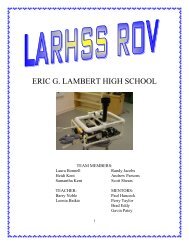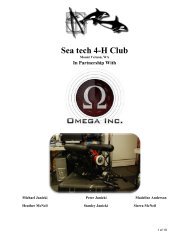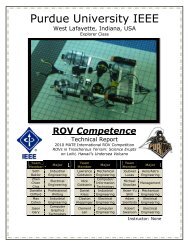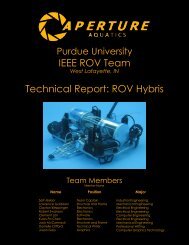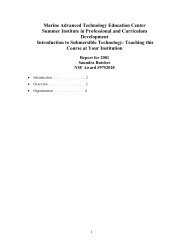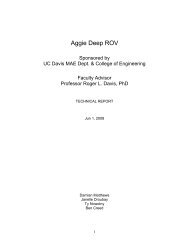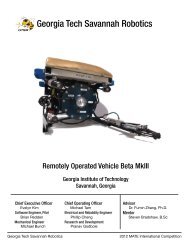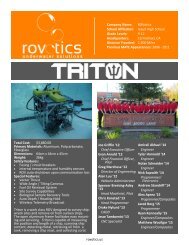technical report - the Marine Advanced Technology Education (MATE)
technical report - the Marine Advanced Technology Education (MATE)
technical report - the Marine Advanced Technology Education (MATE)
Create successful ePaper yourself
Turn your PDF publications into a flip-book with our unique Google optimized e-Paper software.
The basic concepts of Akvator-3D “on<br />
board” circuit organization and pressure<br />
hull design are modular and<br />
interchangeability principles. Such solution<br />
allows us quick repair opportunities and<br />
gives us a chance for easy adding new board<br />
circuits in <strong>the</strong> pressure hull. Hence, future<br />
improvements and adding new tools<br />
wouldn’t be as complicated as <strong>the</strong>y were<br />
before.<br />
Power unit (Fig. 2) contains two DC-<br />
DC converters (48V to 12V and 48V to 5V),<br />
which supply all ROV units with electrical<br />
energy. Total power consumption is limited<br />
by 2kW. That is why 40A safety fuse is used.<br />
Propulsion system control circuit is<br />
based on 8 H-bridges formed by N-channel<br />
metal-oxide-semiconductor field effect<br />
transistors (MOSFET) IRFP4568. L6390 halfbridge<br />
gate drivers are used for controlling<br />
<strong>the</strong> H-bridge MOSFETs. STM Electronics<br />
recommends bootstrap circuitry to supply<br />
<strong>the</strong> high voltage section of <strong>the</strong> h-bridge.<br />
Using this circuitry has some disadvantages.<br />
The most important one for us is that<br />
bootstrap circuitry has limited duty-cycle<br />
(from 5% to 90%). We solved this problem<br />
by replacing <strong>the</strong> bootstrap circuitry and<br />
using TME1212 dc/dc converter instead.<br />
Propulsion control system circuit is<br />
driven by 16 PWM signals. Components of<br />
<strong>the</strong> circuit were selected in such a way that<br />
power dissipation on <strong>the</strong>m is low that<br />
means that <strong>the</strong> circuit doesn’t heat up and<br />
doesn’t influence stability of <strong>the</strong>rmo<br />
sensitive chips. Also mounting heat<br />
radiators and developing cooling system are<br />
not required. Thruster control electric<br />
circuit diagram is presented in Figure 3.<br />
Propulsion control system is<br />
represented by two boards - horizontal and<br />
vertical motion thruster’s controllers. These<br />
boards are schematically identical, which<br />
makes <strong>the</strong>m easier to produce and to replace<br />
failed ones “in <strong>the</strong> field”. There are also two<br />
backup MOSFET half-bridges on each board<br />
to operate ROV lighting system. Besides,<br />
<strong>the</strong>y allow us to complete a control system<br />
of <strong>the</strong> hydraulic manipulator with three<br />
degrees of freedom.<br />
Akvator-3D control systems are<br />
based on Atmel microcontroller units. All<br />
MCUs are connected via I 2 C bus.<br />
Communications block diagram is<br />
presented in Figure 4.<br />
The electronics housing contains 4<br />
boards at <strong>the</strong> moment: vertical and<br />
horizontal motion thrusters controllers,<br />
communication controller and pressure<br />
sensor processing board. DC-DC converters<br />
are also located on those boards.<br />
Fig. 2 Power supply circuit<br />
5



